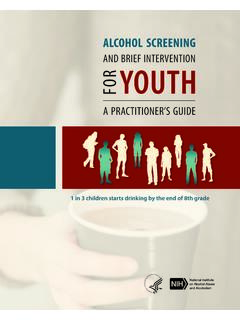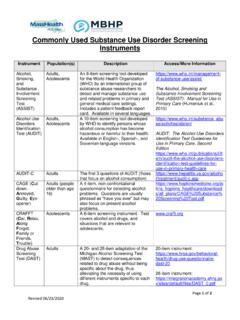Transcription of EARLY IDENTIFICATION AND INTERVENTIONS FOR …
1 INTERNATIONAL JOURNAL OF SPECIAL EDUCATION Vol 21 2006. EARLY IDENTIFICATION AND INTERVENTIONS FOR CHILDREN. AT RISK FOR LEARNING DISABILITIES. Stephen M. Lange &. Brent Thompson West Chester University of Pennsylvania We propose that a model for EARLY screening of children aged 3-5 years for vulnerability for learning disabilities risk can result in preventive INTERVENTIONS , including collaborative INTERVENTIONS planned through parent-professional partnership. The goals of screening and preventive services would be to mitigate increased risk of learning disabilities in elementary school years. The present article describes the rationale for EARLY screening , dimensions that should comprise brief screening tools for use from ages 3-5 years, and potential preventive INTERVENTIONS that have empirical support. The diagnosis of learning disabilities is often determined when children begin to exhibit academic difficulties in school, and the average age when children receive learning disabilities assessments is 9years (Shaywitz, 1998).
2 Delayed intervention can result in adverse and persistent consequences for academic skill acquisition. In contrast, EARLY IDENTIFICATION of children at risk for learning disabilities may offer the potential to mitigate the negative effects of delayed intervention by directing children to preventive services at an earlier age. This is persuasively argued by a National Institutes of Health consensus report, Emergent Literacy Workshop: Current Status and Research Directions, which asserted that diagnosis at kindergarten or first grade is too late (National Institutes of Health [NIH], 2000). A Developmental Model of Learning Disabilities A complicating issue in learning disabilities intervention generally, with implications for prevention, is the ongoing debate surrounding definition of learning disabilities and how or whether -- they may be appropriately diagnosed.
3 We assume that learning disabilities can be defined as an adverse developmental outcome (Geary, 2004; Gersten, Jordan & Flojo, 2005). resulting in unexpected and significant (Fletcher, Coulter, Reschley & Vaughn 2004). difficulty with basic academics. We assume that learning disabilities result from multiple vulnerabilities that arise from biological, psychological, and social systems and their complex interactions (Rueda, 2005). Specifically, children who demonstrate learning disabilities during their elementary school years demonstrate EARLY biological vulnerabilities including a genetic liability for mild cognitive delays or low birth weight. Once biologically vulnerable children begin to lag behind peers, their interaction with their social world and with modes of instruction systematically differ from their peers'. The interaction between an earlier vulnerability and response to intervention has been specifically studied for children who demonstrate reading disorders: Once children who have greater difficulty than peers developing reading fluency they begin to lose opportunities to practice reading connected discourse as they spend increased time learning foundation skills such as phonetic decoding.
4 This places initially struggling readers at a continuing disadvantage as they progress through public education. Further, children who initially struggle to read passages lose access to the language experiences and content information available in print (Torgesen, 2000). Consequently, we propose a cross-theoretical, evidence- based standard for identifying vulnerabilities to target for prevention. In other words, EARLY developmental factors that consistently predict learning disability diagnosis merit consideration as targets for preventive services, and are presumed to confer vulnerability. 108. INTERNATIONAL JOURNAL OF SPECIAL EDUCATION Vol 21 2006. Differing theoretical positions regarding the etiology of the learning disability construct may lead to preventive services that emphasize different vulnerabilities, and approaches which target different vulnerabilities are not presumed to be mutually exclusive.
5 For example, Head Start is an example of a very comprehensive preventive intervention for academic failure that simultaneously intervenes with multiple, interacting, and dynamic systems including familial, community, economic, psychological, and biological systems. The purpose of our paper is to focus attention on the development of prevention strategies that identify young children who demonstrate a set of intrinsic, presumably organically determined vulnerabilities, particularly those that are associated with mild cognitive impairment and more specifically language delays. The importance of developing prevention strategies that mitigate risk for learning disabilities is suggested by the consensus criteria used to determine how to invest prevention resources: Priority is assigned to disorders that have a high prevalence, and those which are associated with developmental trajectories that can result adverse behavioral, social, and psychological outcomes (Biglan, Mrazek, Carnine & Flay, 2003).
6 Learning disabilities are indeed prevalent, and as many as 17 percent of the population may have learning disabilities (Lyon, 2005). The importance of EARLY intervention for children at risk for learning disabilities is further illustrated by their potentially pervasive effects on development. While those with learning disabilities constitute a heterogeneous and diverse population with varied outcomes, adverse consequences of learning disabilities can persist across the lifespan and extend beyond academic skill acquisition to more complex developmental tasks (National Research Center on Learning Disabilities [NRCLD], 2002). During childhood, individuals with learning disabilities face a complicated and challenging task of integrating their disability into an emerging self-concept. Children who have difficulty with this task and employ immature strategies such as denial or disavowal can become harsh self-critics.
7 These children thus have an increased lifetime risk for a broad range of psychiatric disorders (Esser, Schmidt, &. Woerner, 1990), and particularly depressive disorders and Posttraumatic Stress Disorder (McNulty, 2003). For example, when compared to other pupils, college students with learning disabilities were found to be nearly three times more likely to have depressive illness, and have more problems with their grades and quality of their coping skills (Arnold, 2000). Even when the consequences of learning disabilities such as harsh self-appraisal do not merit psychiatric diagnoses, children and adults with learning disabilities can still experience diminished confidence in the efficacy of their own academic, cognitive, and occupational efforts, having internalized repeated exposure to frustration (Cummings, Maddux, & Casey, 2000).
8 As members of the adult workforce, those with learning disabilities are more likely to experience unemployment, or underemployment, and to earn less than non-disabled adults (Cummings et al., 2000). Even among adults who possess college degrees, routine workplace demands can prove more difficult for employees with learning disabilities than for their coworkers, diminishing their productivity and value to employers (Dickenson & Verbeek, 2002). During EARLY childhood, the term vulnerability aptly describes risk for learning disabilities. By itself, assessment that identifies biological risk factors for learning disabilities are neither sensitive nor specific enough for learning disability diagnosis (Jenkins & O'Connor, 2002;. O'Connor & Jenkins, 1999; Schatschneider & Torgenson, 2004). The responsibility for surveillance is shared among multiple social systems including families and the medical care, daycare and educational systems.
9 In particular, physicians and other professionals who interact with young children and who have training in child development are encouraged to provide surveillance for EARLY signs of language and learning disorders (AAP, 2001). Biological Predictors Vulnerabilities for Learning Disabilities Organic factors are indeed associated with increased risk of learning disabilities (Scarborough, 1990). These include genetic liability for mild cognitive disorders, low birth 109. INTERNATIONAL JOURNAL OF SPECIAL EDUCATION Vol 21 2006. weight, and previous evidence of comorbid mild cognitive disorders. With respect to genetic liability, studies of heritability of learning disabilities indicate that the parent-child and sibling concordance rates for learning disabilities are 25-60% and 40% respectively. Multi-gene transmission of learning disabilities is the suggested mechanism (Olsen, Wise, Conners, Rack, & Fulker, 1989; Plomin & Walker, 2003).
10 Because genes implicated in transmission of learning disabilities may also be implicated in other cognitive disorders, siblings and children of individuals with Attention Deficit Hyperactivity Disorder (ADHD) and Autistic Spectrum Disorders need to be considered at risk as well (Faraone & Biederman, 1993; Williams, Oliver, Allard, & Sears, 2003). Low birth weight (birth weight less than 2500 grams or approximately 5 pounds- 6 ounces) predisposes children to delays in development of visuo- spatial and language skills, especially for children with socio-familial stressors such as poverty, or who need more intensive medical intervention following birth (Breslau, Johnson, & Lucia 2001; Kanzawa, Shimizu, Kamada, Tanabe, & Itoigawa, 1997; Ross, Lipper, &. Auld, 1996; Stanton-Chapman, Chapman, & Scott, 2001). Finally, with respect to prior diagnosis of mild cognitive disorders, a previous ADHD diagnosis indicates learning disabilities vulnerability.














